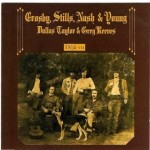Memory is a funny thing. I struggle to recall events my friends, wife and kids remember vividly. Names continually elude me. But what really puzzles me is the relatively mundane — even inane — things that I clearly recall.
 A perfect example is Déjà Vu, the album released on March 11, 1970, by Crosby, Stills, Nash & Young. I still recall the first time I seriously looked at and considered the album. It was in a store in California in the summer of 1970. I can’t tell you the name of the city or town but I do remember it was pouring rain and that’s why we ducked into the store. I also remember I bought a bumper sticker there that read, “They Shoot Students, Don’t They?”, a protest against the May 1970 Kent State shootings that was a takeoff on a popular 1969 movie.
A perfect example is Déjà Vu, the album released on March 11, 1970, by Crosby, Stills, Nash & Young. I still recall the first time I seriously looked at and considered the album. It was in a store in California in the summer of 1970. I can’t tell you the name of the city or town but I do remember it was pouring rain and that’s why we ducked into the store. I also remember I bought a bumper sticker there that read, “They Shoot Students, Don’t They?”, a protest against the May 1970 Kent State shootings that was a takeoff on a popular 1969 movie.
I didn’t buy the album at the time, even though it had reached No. 1 on the album charts in May. I recall that one of the things that intrigued me was the look and feel of the cover, somewhat leathery-like under the cellophane wrapper.
Although Neil Young appeared with David Crosby, Stephen Stills and Graham Nash at Woodstock in 1969, this was the first studio recording in which he was a member of the band. And despite the fact they would tour as CSN&Y upon the album’s release, it was the last studio album of the foursome until 1988’s disappointing American Dream. The only LPs billed as CSN&Y that appeared in the interim were 1971’s 4 Way Street, a double album recorded on their tour in support of Déjà Vu, and So Far, a “greatest hits” compilation released in 1974.
Déjà Vu seems to reveal some of the fractiousness that somehow seemed inherent in the band and that would appear throughout its off-and-on history. The rendition of Joni Mitchell’s “Woodstock” and the song “Carry On,” converted to even more impressive levels in live performances, represented CSN&Y as a group. The balance of the LP seemed to be each member performing his own songs with a bit of help from the others. In fact, Nash said later the band was frequently “at each other’s throats” while Stills estimated it took 800 hours of studio time to complete the album.
Not surprisingly, Nash penned the songs that took off from the LP. Even with its steel guitar (contributed by Jerry Garcia), “Teach Your Children” was typical hippie era music while the piano hook in “Our House” seems destined for radio success. Personally, I favor the back-to-back “4 + 20” by Stills and the multi-part “Country Girl” by Young. Although clearly a downer of a song (the last lyric being, “And I find myself just wishing that my life would simply cease”), “4 + 20” is quintessential acoustic Stills but barely clocks in at two minutes. “Country Girl,” on the other hand, is a different sound than one might expect going into the album. And it and Young’s other contribution, “Helpless,” plainly distinguish his work.
Just as the band was seemingly divided during the recording, the LP also split CSN&Y fans. The harmonies may not be quite as exquisite as on Crosby, Stills & Nash and others are disappointed in the guitar work given that both Stills and Young are part of the band. Those who like the album feel its variety and range are its strength, even if it isn’t as cohesive as the debut album. I probably tend to listen to Déjà Vu more but that may well be because of my partiality to Young’s work and “Country Girl.”
In closing, it’s also probably worth noting that while there is a hippie feel to some of the songs — “Teach Your Children” and “Almost Cut My Hair,” for example — this was a vibe that was giving way to other topics and feelings. As such, Déjà Vu may as much reflect something that was disappearing, not the illusion that surrounds a first time experience.
If I had ever been here before I would probably know just what to do
Don’t you?
Title track, CSN&Y, Déjà Vu







